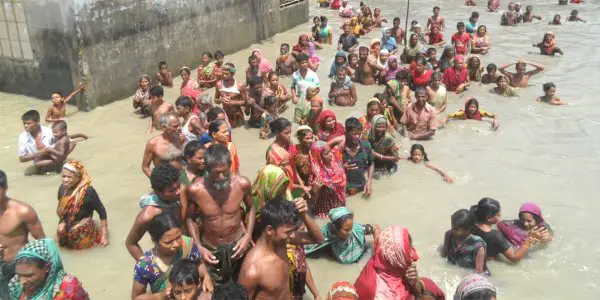41 Million Affected And 1,200 Dead By Flooding In India, Bangladesh And Nepal
Tags: opinion

By Amanda Froelich Truth Theory
Because much of North American media has been focused on Hurricane Harvey and the looming Hurricane Irma, few have been informed of an even worse natural disaster taking place overseas. In India, Bangladesh and Nepal, weeks of unusually strong monsoon rains have resulted in at least 1,200 deaths. In total, approximately 41 million people have been affected, according to the United Nations.
The New York Times reports that thousands of homes have been destroyed in Nepal, where elephants are being used to rescue people and activists have been constructing rafts from bamboo and banana leaves to save landlocked victims. Despite some successful efforts by aid organizations, hundreds remain missing. As a result, many families have held last rites without their loved ones’ bodies.
To make matters worse, Nepal’s flooded areas are in the poorest parts of the country. Many farms are now underwater, and thousands of people are stuck subsisting under plastic tarps in camps for displaced people. As a result of poor hygiene and cramped conditions, disease is beginning to spread.
In India, floods have poured into the states of Assam, Bihar, Odisha, West Bengal and other areas. Over the weekend, more than 400 people died in floods in Bihar. Soon after, the Prime Minister Narendra Modi promised millions of dollars in assistance and urged insurance companies to send in assessors as soon as possible to help farmers.
In Mumbai, India’s largest city, the city’s transport system is said to be “in chaos.” Mumbai is largely built on reclaimed land and most schools and colleges remain shut. One news report said the city has been “paralyzed by incessant rains.” Reportedly, water is five feet high in some areas of the city.
In Bangladesh, approximately 134 people have died and 700,000 homes have been destroyed. One-third of the country is now subject to flooding.
“This is the severest flooding in a number of years,” said Francis Markus, a spokesman for the International Federation of Red Cross and red Crescent Societies. When Markus was asked to comment on the difference between SE Asia’s floods and what was happening in Houston, Texas, he said: “We hope people won’t overlook the desperate needs of the people here because of the disasters closer home.”
According to experts, climate change has exacerbated the strength of natural disasters in both Houston, Texas, and Southeast Asia. Reaz Ahmed, the director-general of Bangladesh’s Department of Disaster Management, told CNN, “This is not normal … Floods this year were bigger and more intense than the previous years.”
It is imperative the rains and flooding in Southeast Asia receive just as much — if not more — coverage than natural disasters elsewhere, as a larger percentage of citizens in Nepal, Bangladesh and India live below the poverty line. As a result, they will have a much more difficult time recovering from the damages.
Image Credit: Kamrul Hassan, Bangladesh Red Crescent
Via New York Times, EcoWatch
THIS ARTICLE IS OFFERED UNDER CREATIVE COMMONS LICENSE. IT’S OKAY TO REPUBLISH IT ANYWHERE AS LONG AS ATTRIBUTION BIO IS INCLUDED AND ALL LINKS REMAIN INTACT.
I am Luke Miller, content manager at Truth Theory and creator of Potential For Change. I like to blend psychology and spirituality to help you create more happiness in your life.Grab a copy of my free 33 Page Illustrated eBook- Psychology Meets Spirituality- Secrets To A Supercharged Life You Control Here
Leave Comment: